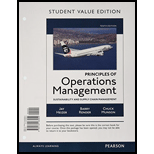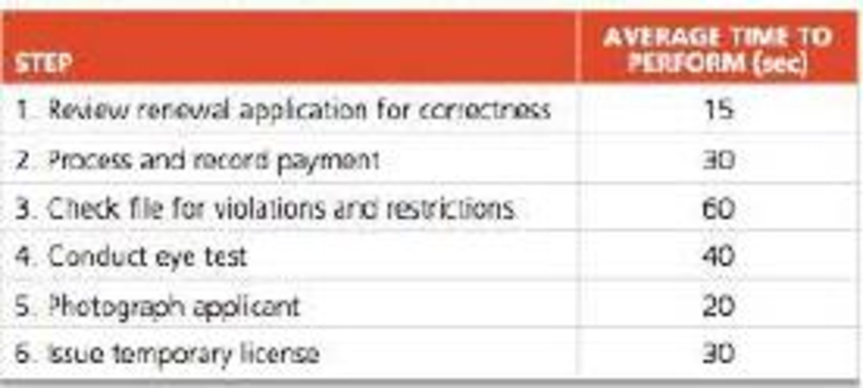
Concept explainers
Henry Coupe, the manager of a metropolitan branch office of the state department of motor vehicles, attempted to analyze the driver’s license-renewal operations. He had to perform several steps. After examining the license-renewal process, he identified those steps and associated limes required to perform each step, as shown in the following table:
State Automobile License Renewal Process Times

Coupe found that each step was assigned to a different person. Each application was a separate process in the sequence shown. He determined that his office should be prepared to accommodate a maximum demand of processing 120 renewal applicants per hour.
He observed that work was unevenly divided among clerks and that the clerk responsible for checking violations tended to shortcut her task to keep up with the others. Long lines built up during the maximum-demand periods.
Coupe also found that Steps 1 to 4 were handled by general clerks who were each paid $12 per hour. Step 5 was performed by a photographer paid $16 per hour. (Branch offices were charged $10 per hour for each camera to perform photography.)
Step 6, issuing temporary licenses, was required by state policy to be handled by uniformed motor vehicle officers. Officers were paid $18 per hour but could be assigned to any job except photography.
A review of the jobs indicated that Step 1, reviewing applications for correctness, had to be performed before any other step could be taken. Similarly, Step 6, issuing temporary licenses, could not be performed until all the other steps were completed.
Henry Coupe was under severe pressure to increase productivity and reduce costs, but he was also told by the regional director that he must accommodate the demand for renewals. Otherwise, “heads would roll.”
3. If the second clerk could be added anywhere you choose (and not necessarily to check for violations, as in Question 2), what is the maximum number of applications the process can handle? What is the new configuration?
Want to see the full answer?
Check out a sample textbook solution
Chapter 9 Solutions
Principles of Operations Management: Sustainability and Supply Chain Management, Student Value Edition (10th Edition)
- What kinds of characterizations may be made for network layouts?arrow_forwardThe City Commission of Nashville has decided to build a botanical garden and picnic area in the heart of the city for the recreation of its citizens. The precedence table for all the activities requi red to construct this area successfully is given. Draw the Gantt chart for the whole construction activi ty.arrow_forwardManagers at the First Community Bank are attempting to shorten the time it takes customers with approvedloan applications to get their paperwork processed. The flowchart for this process, consisting of several differ-ent activities, each performed by a different bank employee, is shown in Figure 5.1. Approved loan applicationsfirst arrive at activity or Step 1, where they are checked for completeness and put in order. At Step 2, the loansare categorized into different classes according to the loan amount and whether they are being requested forpersonal or commercial reasons. While credit checking commences at Step 3, loan application data are enteredin parallel into the information system for record-keeping purposes at Step 4. Finally, all paperwork for setting upthe new loan is finished at Step 5. The time taken in minutes is given in parentheses.Which single step is the bottleneck, assuming that market demand for loan applications exceeds the ca-pacity of the process? The management…arrow_forward
- Jamison Day Consul tants has been entrusted with thetask of evaluating a business plan that has been divided into foursections- marketing, finance, operations, and human resources.Chris, Steve, Juana, and Rebecca form the evaluation team. Each of them has expertise in a certain field and tends to finish thatsection faster. The estimated times taken by each team memberfor each section have been outlined in the following table. Furtherinformation states that each of these individuals is paid $60/hour.a) Assign each member to a different section such that JamisonConsultants's overall cost is minimized.b) What is the total cost of these assignments?arrow_forwardFour Squares Productions, a firm hired to coordinate the release of the movie Pirates of the Caribbean: On Stranger Tides (starring Johnny Depp), identified 16 activities to be completed before the release of the film. The appropriate data are shown in the following table: Time (weeks) Immediate Time (weeks) Immediate Activity a m b Predecessor(s) Activity a m b Predecessor(s) A 1.0 2.0 4.0 — I 10.5 13.0 14.0 C B 2.0 3.5 6.0 — J 2.0 4.0 6.0 C C 10.0 12.0 14.0 — K 2.0 4.0 6.0 D D 4.0 5.0 7.0 — L 3.0 5.0 7.0 E E 2.0 4.0…arrow_forwardColonial State College is considering building a new multipurpose athletic complex on campus. The complex would provide a new gymnasium for intercollegiate basketball games, expanded office space, classrooms, and intramural facilities. The following activities would have to be undertaken before construction can begin: Need answers and explanation. Thanks, appreciate it! :)arrow_forward
- Why are process layouts plagued by routing and scheduling issues?arrow_forwardTask time estimates for the modification of an assembly line at Jim Goodale's Carbondale, Illinois, factory are as follows: Activity Time (in hours) Immediate Predecessor(s) A 5.0 - B 6.5 - C 5.0 A D 5.0 B, C E 4.0 B, C F 7.5 D G 4.0 E, F This exercise contains only parts d, b, and c. d) Using the line drawing tool five times, draw a Gantt chart for activities C through G of the project based on the early times. Carefully follow the instructions above, and only draw the required objects. b) The critical path activities for the leadership training program development project are c) The expected project completion time for the leadership training program development project = hours (round your response to one decimal place).arrow_forwardWhy it is permissible for two operations that manufacturer and distribute the same product to have distinct process layouts?arrow_forward
- Make a SWOT analysis of Site or office (workstation)arrow_forwardJamison Day Consultants has been entrusted with thetask of evaluating a business plan that has been divided into foursections—marketing, finance, operations, and human resources.Chris, Steve, Juana, and Rebecca form the evaluation team. Eachof them has expertise in a certain field and tends to finish thatsection faster. The estimated times taken by each team memberfor each section have been outlined in the table below. Furtherinformation states that each of these individuals is paid $60/hour.a) Assign each member to a different section such that JamisonConsultants’s overall cost is minimized.b) What is the total cost of these assignments?Times Taken by Team Members for Different Sections (minutes)MARKETING FINANCE OPERATIONS HRChris 80 120 125 140Steve 20 115 145 160Juana 40 100 85 45Rebecca 65 35 25 75arrow_forwardA measure used to evaluate a workcenter layout is?arrow_forward
 Practical Management ScienceOperations ManagementISBN:9781337406659Author:WINSTON, Wayne L.Publisher:Cengage,
Practical Management ScienceOperations ManagementISBN:9781337406659Author:WINSTON, Wayne L.Publisher:Cengage, Operations ManagementOperations ManagementISBN:9781259667473Author:William J StevensonPublisher:McGraw-Hill Education
Operations ManagementOperations ManagementISBN:9781259667473Author:William J StevensonPublisher:McGraw-Hill Education Operations and Supply Chain Management (Mcgraw-hi...Operations ManagementISBN:9781259666100Author:F. Robert Jacobs, Richard B ChasePublisher:McGraw-Hill Education
Operations and Supply Chain Management (Mcgraw-hi...Operations ManagementISBN:9781259666100Author:F. Robert Jacobs, Richard B ChasePublisher:McGraw-Hill Education
 Purchasing and Supply Chain ManagementOperations ManagementISBN:9781285869681Author:Robert M. Monczka, Robert B. Handfield, Larry C. Giunipero, James L. PattersonPublisher:Cengage Learning
Purchasing and Supply Chain ManagementOperations ManagementISBN:9781285869681Author:Robert M. Monczka, Robert B. Handfield, Larry C. Giunipero, James L. PattersonPublisher:Cengage Learning Production and Operations Analysis, Seventh Editi...Operations ManagementISBN:9781478623069Author:Steven Nahmias, Tava Lennon OlsenPublisher:Waveland Press, Inc.
Production and Operations Analysis, Seventh Editi...Operations ManagementISBN:9781478623069Author:Steven Nahmias, Tava Lennon OlsenPublisher:Waveland Press, Inc.





